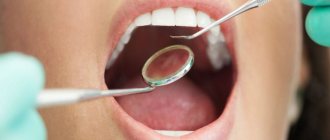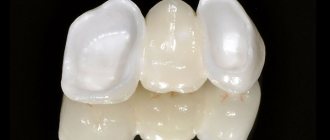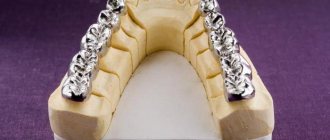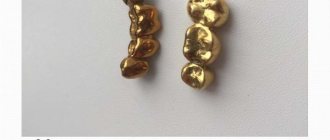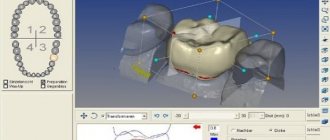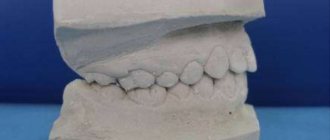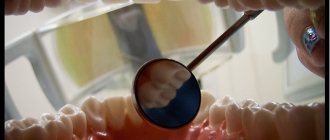Dental bridges are a modern and reliable method of prosthetics. In essence, it is simple - several connected crowns are put on the teeth. The central ones restore missing teeth, and the outer ones are made in the form of caps and are put on the ground supporting dental units.
Bridges
Dental bridge: general characteristics
With the help of prosthetics, a number of visual and functional dental problems are solved. The name for the installation was not chosen by chance, because the principle of the device is reminiscent of engineering structures. Artificial crowns are held on a base, and adjacent intact incisors, canines and molars act as supporting elements.
The choice of the appropriate type of construction depends not only on the financial capabilities and personal preferences of the patient, but also on his medical history. That is why a full restoration is impossible without a thorough diagnosis, medical examination and adjustment of the finished system, created from casts, to the required parameters.
Types of Dental Bridges
Modern dental clinics offer many options for restoring lost units using prosthetic bridges. They differ according to different criteria:
- by manufacturing method - solid cast, adhesive, stamped, pressed, combined;
- by material - metal, metal-ceramic, ceramic, plastic, zirconium dioxide and aluminum oxide;
- according to the method of fastening - locking, adhesive, on healthy teeth, on implants.
There is also a classification according to purpose. For example, artificial prostheses are restorative, splinting, temporary and permanent.
Manufacturing technology
The main selection criterion is the amount of time spent on creating a design according to the individual standards of a particular patient. There are 3 main groups:
- Solid cast. Ideally adjacent to hard and soft tissues, airtight. In this way it is possible to reproduce the natural shape with high precision. They are strong and durable. The disadvantages include the need to grind healthy teeth, as well as the use of high-precision casting and the high cost of production.
- Adhesive. Modeling takes place directly in the oral cavity. This is a gentle alternative to the previous method when only one element is missing. There is no need to grind the adjacent crowns; the plates are glued to them using a special cement composition.
- Stamped. An outdated option that most doctors refuse because the product weighs a lot and often leads to injury to the supports.
Material for production
The type of raw materials from which products are made determines their durability, practicality and care. Modern clinics offer many options to suit every taste and budget. Types of bridges and their features (photos are presented in the article):
- Metal. They were actively used decades ago, cast from precious metals, gold and silver. They are distinguished by high strength and affordable price. However, this type has a significant drawback: the dentition looks unattractive. Damage to the supporting elements is also possible.
- Metal-ceramic. The base consists of an alloy, which is complemented by ceramic inserts. This option is considered ideal with an optimal ratio of cost and high quality. The color is matched to the shade of the enamel.
- Ceramic. There is no all-metal cast frame. These teeth look quite natural, but do not tolerate strong mechanical stress due to their fragility. You need to be very careful when wearing it.
- Plastic. They are used primarily as temporary substitutes for permanent products while they are being manufactured in the laboratory. They are produced very quickly, do not cause allergic reactions, weigh little, look attractive, but do not last long.
- Made from zirconium dioxide. All-ceramic combined dental bridges on this basis are among the most modern. They absorb all the advantages of their predecessors: light weight, reliability, aesthetic appeal, hypoallergenicity, long service life.
- Made from aluminum oxide. They are not widespread enough because they have an exorbitant price. In terms of durability, strength, beauty and other characteristics, they have proven themselves exclusively on the positive side.
Mounting type
The structures are attached in different ways, the most common in dentistry:
- Consolidation on healthy units. The product consists of crowns with holes intended for teeth and bridges that connect them. For strength, the elements are made solid. When choosing this type, preliminary grinding and depulping will be required. Dentists are resorting to the latter procedure less and less; modern technologies make it possible in some cases to skip this stage.
- On implants. When choosing this method, intact incisors, canines and molars remain intact. They will not be ground or depulped. However, the cost of treatment increases significantly.
- Adhesive method. The bridge is not put on supports, but is attached to the rear surface using special composite compounds.
- Lock fastening. This is a removable bridge, which, if necessary, can be detached and returned to its place. Grinding of the abutment crowns is also not carried out.
Which bridge structures are best?
When it is planned to fix a bridge prosthesis on the front teeth, its price leaves much to be desired, since we are talking, first of all, about aesthetics. To produce artificial teeth that replicate natural teeth in transparency and shade, it is necessary to use high-quality material – zirconium dioxide.
In addition, the specialist’s work is greatly complicated by situations caused by excessive exposure of the patient’s gums when smiling, as well as those associated with a significant degree of transparency of the enamel. In this case, the question of how much a bridge costs takes a back seat, since the primary goal is to achieve impeccable aesthetic characteristics.
However, if a bridge is placed over chewing teeth, then functionality becomes a priority.
Next, we will consider the following types of bridges:
- Metal-ceramic structures;
- Adhesive bridge prosthesis;
- Zirconium dioxide products;
- Solid-cast bridges.
Indications and contraindications for installation
The procedure is indicated when a person is missing one molar or 1-4 front incisors and canines. In this case, intact teeth should remain on the sides, which will subsequently act as supporting elements and withstand the greatest pressure when chewing food. Also, this cannot be avoided when the previous design has become unusable.
Despite all the advantages of orthopedic intervention, there is a list of cases when it is contraindicated:
- absence of more than 4 crowns;
- bruxism (involuntary grinding of the jaws, which is most often observed at night);
- malocclusion (before prosthetics you will have to undergo long-term orthodontic treatment);
- acute form of periodontitis or severe periodontal disease;
- pathological abrasion of the enamel layer;
- diseases of the skeletal system (for example, osteomyelitis);
- inflammatory processes in the oral cavity;
- poor hygiene preventing installation.
In addition, this also includes general contraindications to surgical intervention. These are problems with blood clotting, allergic reactions to drug components, manufacturing materials, chronic diseases during exacerbation, taking medications that prevent blood clots, and mental disorders.
Types of structures according to the degree of adherence to the mucosa
Bridges are usually divided not only by the method of fixation and by the materials from which they are made. The degree of contact between the intermediate part of the prosthesis and the mucous membrane is also important when choosing. Let's look at the possible options:
- flushing: the most common type. The bridge with its intermediate part (i.e. the crown that directly restores the missing tooth) does not fit tightly to the gum. Therefore, several millimeters of free space remain between it and the mucous membrane. Firstly, the gap is washed with saliva, thanks to which it is possible to achieve cleansing of the oral cavity in a natural way. Secondly, the microslot allows the patient himself to successfully carry out hygiene procedures,
- tangents: the bridge is in contact with the mucosa on only one side. As a rule, this option is relevant when restoring the anterior units, where the aesthetics of the smile is extremely important,
- saddle-shaped: structures that are completely under the gum and are in contact with it on both sides. They are quite rare, since from a hygienic point of view they are completely unsafe, but in some cases you cannot do without them.
Complex on 4 OSSTEM implants with delayed loading - 140,000 rubles.
Complex implantation Osstem (South Korea) with delayed loading after 4-6 months.
Doctor's work guarantee - up to 5 years (under an agreement on the provision of medical services) Call now or order a call
Opening hours: 24 hours a day - seven days a week
Advantages and disadvantages of dental bridges
Advantages of bridges in prosthetic dentistry:
- There is no need to wait for the installed structure to take root. That is, there is no need for osseointegration, which can last up to six months. It turns out that the adaptation process lasts quite quickly (up to 12 hours).
- This is the most economical option for restoring rows when individual units are lost than implantation.
- Modern technologies make it possible to obtain aesthetically attractive artificial teeth with full functioning. Hidden elements (fastenings, etc.) are not visible to others, so no one will even notice the medical intervention.
- The procedure has virtually no contraindications. A bridge is also placed in cases where implantation of an implant is not possible.
- Normal diction is maintained.
Weak sides:
- It is necessary to grind down the adjacent crowns remaining in the mouth. Very often, dentists resort to depulpation (removal of the nerve, cleaning and cementing of the canals).
- The normal load on the jaw bone is not fully restored. When a person chews food, the supports are loaded; the central part is practically not involved in this. As a result, the risk of bone tissue atrophy increases.
Installation of a dental bridge: stages of the procedure
The process of manufacturing and installing the structure is simple and does not require additional actions aimed at violating the integrity of soft tissues, suturing, etc. The adaptation period is easy and painless. Despite its simplicity, the doctor and patient will have to go through several successive steps before the lost units are completely restored. On average, 3 visits to the dental office will be required.
Stage 0: sanitation of the oral cavity before the procedure
If during the initial examination the specialist suggested installing a bridge, he should carefully examine the oral cavity. One of the main conditions for prescribing treatment is the absence of carious lesions, inflammatory processes and other dental disorders.
The duration of this period depends on the condition of hard and soft tissues. If a person regularly visits the clinic for preventive purposes, it is likely that a routine cleaning will be required without applying filling material. If there are advanced diseases, they must be treated, and only then can you contact an orthopedist.
Stage 1: preparation of abutment teeth and production of a bridge.
When the dentist is sure that all units are completely healthy, a support is selected. The elements are ground, depulped, and the roots are filled.
Impressions are taken from the finished fastenings. They are sent to the dental laboratory.
While the permanent product is being manufactured, the patient will have to wear a temporary one with a plastic base. This may take 1-2 weeks depending on the workload of the institution and the complexity of the technological processes.
When there are not enough natural teeth, or they are of too poor quality, they cannot be cured and properly prepared for the procedure, implantation is indicated. Typically two anchor points are implanted.
Stage 2: installation of a fixed prosthesis
At the last visit to the dental clinic, the plastic structure is dismantled, and in its place is installed one made in the laboratory using impressions. The orthopedist checks how tightly the material adheres to the surfaces. There should be no obstruction to the closure of the jaws and no visible color differences, otherwise the artificial areas will be noticeable.
A full fitting, fitting and fixation is carried out. For greater reliability, special cement is applied.
If the client feels discomfort, prosthetics are not performed. The system is dismantled and returned to the laboratory for adjustment. If there are no unpleasant sensations, the treatment is completed.
Adaptation occurs even while wearing plastic. This means that the patient will be able to easily return to their normal lifestyle within a few hours. The doctor gives recommendations on the use and care of the product, prescribes routine examinations and provides other important information.
Patient reviews
“I had two bridges. They were installed at different times by different doctors. The one that was installed first stands like a glove, although 7 years have already passed. The second one was installed about 2 years ago, and I’ve already suffered enough with it. At first it was installed poorly, it seemed to be in the way, then everything started to ache and ache. In the end, everything had to be removed, plus one tooth was removed. I come to the conclusion that everything depends on the quality of preparation for prosthetics and on the doctor who did it all.”
Detkova, review from correspondence on the baby.ru forum
“I installed an adhesive device a year before implantation. I just needed time to save up, I was a little short on money. I liked that the native tooth was not damaged by it, not during installation, not while wearing it. I was satisfied with everything, but, as the doctor told me, it was no longer possible to wear it, otherwise the supporting tooth underneath would have already begun to deteriorate severely and be damaged. And so, everything is OK!”
Marinel, otzovik.com
“Metal ceramics solved my little problem with my molars very successfully. I've been wearing it for 9 years without any complaints. One drawback is that it has already become quite noticeable that the gums have sagged under the central crown and food gets in there; it can only be cleaned out with an irrigator. I'll probably wear it until it won't bother me, because... I don’t have it in front, but on the side – when I smile and talk, it seems to be unnoticeable to others.”
Kisa, woman.ru
- Bazhenova N.P. Experience in the use of bridges made of light-curing composite. Kuban Scientific Medical Bulletin, 2006.
- A.A. Kushnareva, A.R. Sargsyan. Dental implantation as an alternative to bridges and removable dentures. Health and education in the 21st century, 2014.
Author: Sambuev B. S. (Thank you for your help in writing the article and the information provided)
Recommendations after installation
Artificial structures also need to be properly maintained. If hygiene rules are not followed, this will significantly reduce the life of the product, and the patient will again have to use the services of an orthopedist.
Dentists recommend the following measures when performing dental prosthetics with bridges:
- Daily cleaning in the morning and evening. You must use a brush and paste. After each meal, you need to rinse your mouth with clean water or mouthwash, and use floss (dental floss).
- Hard-to-reach areas and interdental spaces are cleaned using sweeping movements without pressing on the crowns.
- It is important to exclude hard nuts, seeds and other foods from your diet that can cause chips and cracks.
- During the first time after installation, you should not drink coffee and tea, red wine, or freshly squeezed juice.
- You should visit the dental clinic for preventive examinations at least once every six months and undergo professional cleaning.
All structures have a certain service life. It depends on the material used and manufacturing technique. This period varies from 5 to 15 years. Sooner or later the product will have to be replaced, otherwise it may simply break and fall out.
The device is dismantled prematurely with the following problems:
- loosening;
- broken crowns;
- chipping of small fragments, appearance of microcracks;
- inflammation of soft tissues, bleeding gums;
- washing out the cement composition on which the system rests.
Only a specialist can safely remove the prosthesis; you cannot do it yourself at home. If you follow all the rules listed above, your smile will remain dazzling for a long time, and replacement will not be needed soon.
Metal-ceramic crowns
When a tooth is very badly damaged or its color has changed and darkened due to previous treatment, it is necessary to make a metal-ceramic crown. The approaches to dental prosthetics with crowns in the clinic are radically different from those traditionally used. Thus, there is no need to “depulpate” the tooth, i.e. remove the “nerve” from it because during preparation the tooth is processed with a special method that allows you to very precisely remove just enough tissue so that a cosmetic crown can be made.
In addition, the metal-ceramic crown fits so precisely to the tooth that the border is absolutely smooth, this has a beneficial effect on the life of the crown and the healthy condition of the gums.
How much does it cost to build a bridge?
The price for dental bridge crowns is determined by the cost category of the impressions, the design itself, installation and fitting services. There are the cheapest options available to most patients, but they will be significantly inferior to the more expensive ones in terms of operational and other characteristics.
On average, a budget bridge can be installed for 3 thousand rubles. Zirconium and metal-ceramic elements will cost 20 thousand or more, especially if implantation was performed.
The main factors on which the final installation cost depends
What affects the cost of orthopedic intervention:
- Material of manufacture. Plastic can be purchased several times cheaper than metal or ceramics. The last option with a zirconium dioxide frame is the most expensive.
- Application of implants. They can significantly increase the number of zeros on a check.
- Number of elements to install.
- Clinic location. Treatment in Moscow is much more expensive than in the regions.
- Pricing policy of a dental institution. This is due to market conditions, competitiveness, status and reputation of dentists.
Prosthetics allows you to restore lost teeth in a short time and without large material costs. When installing the structure, certain conditions must be met, and the patient must go through several successive stages. Unfortunately, despite the obvious advantages, bridges are not without their negative aspects. In addition, there are contraindications when it is not possible to restore the aesthetic appeal of a smile without harm to health in this way.
Classification
Solid-cast bridge structures are prostheses made without the use of connecting techniques, which eliminates breakage at the soldering site, errors in the manufacture of the device and guarantees the presence of a base from the only material chosen by the patient.
Most often, the design is made of gold, silver-paldium or cobalt-chrome alloy. The latter are often coated with gold plating or ceramics to improve aesthetics.
